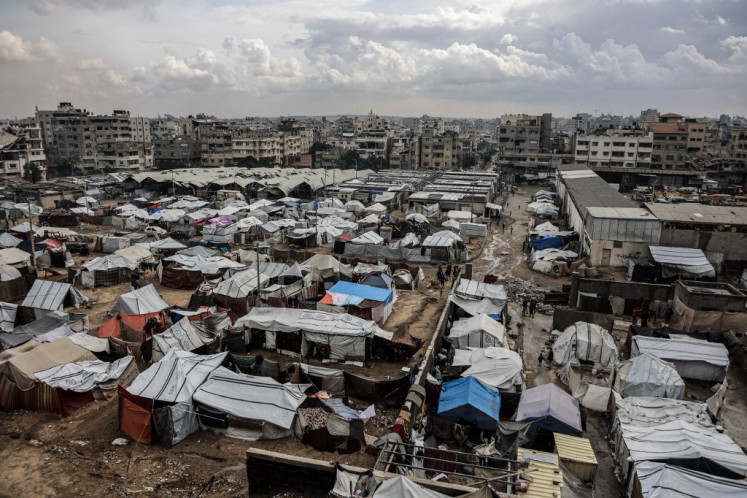Popular Reads
Top Results
Can't find what you're looking for?
View all search resultsPopular Reads
Top Results
Can't find what you're looking for?
View all search resultsFestival supports local filmmakers
On film: A Bali Hindu ritual is performed on Nyepi on March 5
Change text size
Gift Premium Articles
to Anyone
O
span class="caption" style="width: 398px;">On film: A Bali Hindu ritual is performed on Nyepi on March 5.Amid the noisy celebrations of traditional and contemporary performing arts at the recent month-long Bali Arts Festival, one event made its mark in a modest way.
That event was the Bali Documentary Film Festival.
The festival was arguably the first coordinated effort to educate the island’s youth on the importance of documentary filmmaking. It was also an effort to encourage them to create documentary films about their homes based on their own perspectives.
“We want these young people to realize that they have a pivotal role in creating and recreating the visual images and visual histories of their island, cultures and people,” writer and filmmaker Agung Bawantara said.
Agung and his colleague, Maria Ekaristi, were the main engines of the festival.
“For decades, even centuries, our collective consciousness and visual history have been shaped by outsiders. It doesn’t mean that the images they presented were wrong or filled with fallacies. It only means that those images were created based on outsider perspectives and not ours,” he said.
Bawantara pointed out how nearly all influential documentary films about Bali were shot and made by non-Balinese, and how those films shaped the way the Western world views Bali and its people.
“Out of hundreds of documentary films about Bali, there are dozens made by Balinese or Indonesians but those works failed to capture the public’s attention,” he said.
He recalled that state-run TVRI television station opened its regional production and broadcasting facility in Denpasar in 1978. Ever since that time, the facility has regularly produced documentary films on various aspects of Balinese life.
“Unfortunately, their quality was not exceptional and the station did not have a good archival facility so a large number of those movies are now damaged,” he said.
In 1996, Bawantara said a prominent political activist in Bali, Putu Suasta, spearheaded an effort to produce a documentary film on eccentric painter Ida Bagus Made Poleng. In 2010, a Bali-born graduate student at the Jakarta Art Institute, I Gede Putu Wiranegara, shot the documentary Bali Menantang Masa Depan. The film was based on extensive research and interviews involving the island’s influential figures from various walks of life.
“Suasta’s and Wiranegara’s works are examples of important documentary film projects initiated and carried out by Balinese. It is about time that the younger generation of Balinese and Indonesians produced their own visual interpretations of their lives,” Bawantara said, succinctly defining the festival’s objective.
The seeds of the festival had been sown a few years earlier when in 2009 a documentary film workshop was held during the annual Bali Arts Festival. The workshop, co-organized by the Bali Cultural Agency and the central government’s Directorate General for Film, was attended by communication officers from every regional administration on the island.
“In 2010, Bali Cultural Agency head IB Sedhawa appointed Agung Bawantara and I to organize a documentary film competition in conjunction with the Bali Arts Festival,” Maria Ekaristi said.
Fourteen participants from all over Bali enrolled in the competition. Sanghyang Dedari, a documentary on the sacred dance of the heavenly nymphs produced by students of SMK 1 senior vocational school in Mas, Ubud, grabbed the top spot.
All the films were later submitted to a national level competition and two documentary films from Bali took first and second prize.
“The success of the competition as well as the achievements recorded by Balinese filmmakers on the national stage convinced the agency to expand the competition in 2011,” Ekaristi said.
And expand it did.
Bawantara and Ekaristi succeeded in securing support from several big names in the country’s film industry. Actress Happy Salma, who is married to an Ubud prince, agreed to be the festival’s ambassador, while Lawrence Blair, who coproduced the famed Ring of Fire documentary on the Indonesian archipelago, agreed to sit on the panel of judges.
The other judges were award-winning director Slamet Rahardjo Jarot, famed photographer Rio Helmi, scholar I Wayan Dibia and Jakarta Arts Institute lecturer Hadiartomo.
“We organized a series of workshops in cities across Bali featuring promising filmmakers Samsul Hadi and Erick EST and at the end of the series we held a gathering in which movie lovers could meet and discuss with Lawrence Blair,” Ekaristi said of pre-festival events.
Photogenic: Balinese women bring offerings to a temple, an image that has been captured for decades in photographs and films. JP/Agung ParameswaraThirty-four young filmmakers from eight provinces sent their work to the festival’s committee. Lampion-lampion, a documentary on the social interactions in Lampu village in Bangli, won first prize. The movie, shot and directed by young filmmaker Dwitra J. Ariana, captured the unique harmonious ambience and heritage of Lampu, a Balinese village with a sizable population of Balinese of Chinese descent.
The second prize went to Opera Batak directed by Andi Hutagalung from Medan, North Sumatra, and third place to Seni Budaya antara Harapan dan Realita directed by Putu Widna Yuniawahari from Bali.
“A large number of the submitted films display a narrative pattern that relies heavily on words, naturally the films tell the story instead of showing the story. A film after all is an audio-visual narration, not a verbal one,” Slamet Rahardjo Jarot said of the general weakness of the young filmmakers.
Despite certain weaknesses, both Bawantara and Ekaristi are convinced that part of their mission has been accomplished. The country now has a larger pool of talented young documentary filmmakers.
“It means that alternative visual images and visual histories of the country, of Bali and of the archipelago will soon be streamed into the public consciousness. And these young filmmakers will be the creators of those alternative stories,” Bawantara said.











